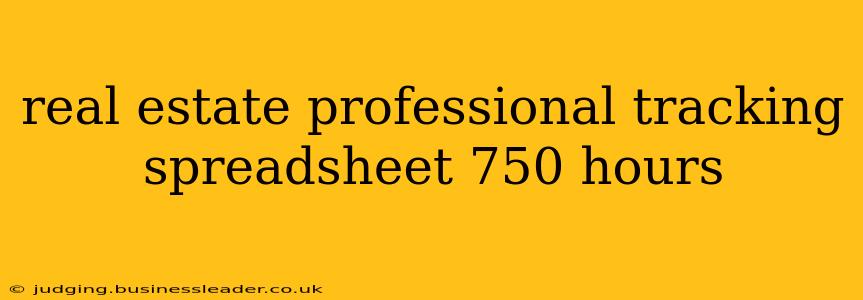For real estate professionals, time is money. Effectively managing your time is crucial for success, and a well-designed tracking spreadsheet can be your secret weapon. This comprehensive guide will walk you through creating a powerful spreadsheet to monitor your 750 hours (or more!), boosting your productivity and ultimately, your income. We’ll cover essential features, helpful formulas, and best practices to maximize your efficiency.
What to Include in Your Real Estate Tracking Spreadsheet
Your spreadsheet should be more than just a simple time log. It needs to provide actionable insights into your activities, allowing you to identify strengths, weaknesses, and areas for improvement. Here's a breakdown of essential elements:
1. Date and Day of the Week:
This forms the foundation of your tracking. Use separate columns for date and day to allow for easy filtering and sorting.
2. Time Blocks:
Break down your day into manageable time blocks (e.g., hourly or half-hourly). This allows for precise tracking of your activities.
3. Activity Description:
This is crucial. Be specific! Instead of "Client Meetings," write "Meeting with John Smith to discuss 123 Main St. property." This level of detail offers invaluable data analysis later. Examples include:
- Client Meetings: Include client names, property addresses, and meeting outcomes.
- Property Showings: Note the property address, client names, and feedback received.
- Marketing & Advertising: Specify the platform (e.g., Zillow, social media) and the time spent.
- Administrative Tasks: Detail tasks like paperwork, email correspondence, and follow-ups.
- Networking Events: Include the event name, contacts made, and potential leads.
- Continuing Education: Record hours spent on courses, workshops, or webinars.
- Prospecting: Note time spent on lead generation activities, like cold calling or online searches.
4. Client Name:
Tracking clients allows for analysis of your performance with individual clients and identification of high-value relationships.
5. Property Address:
For activities related to specific properties, including the address allows for effective tracking of your progress with each listing.
6. Lead Source:
Identify where your leads originate (e.g., referrals, online advertising, open houses). This allows you to optimize your marketing efforts.
7. Outcome/Notes:
Record the results of your activities. Did you secure a showing? Did you close a deal? What were the key takeaways? Detailed notes provide valuable context for analysis.
Formulas for Enhanced Analysis
Leveraging formulas within your spreadsheet will unlock powerful analytical capabilities:
- Total Hours per Day/Week/Month: Use the
SUMfunction to calculate the total hours spent on various activities. - Hours Spent per Activity: Use
SUMIFto calculate the total time spent on specific activities (e.g., total hours spent on client meetings). - Average Time per Activity: Combine
SUMIFandCOUNTIFto calculate the average time spent on each activity type. - Client Performance Analysis: Use pivot tables to analyze your performance with different clients, identifying top performers and areas needing improvement.
H2: How Can I Track My Time Effectively as a Real Estate Agent?
Effective time tracking involves more than just recording hours. It's about mindful allocation and strategic planning. Use time-blocking techniques, prioritizing high-value activities, and utilizing technology like time tracking apps alongside your spreadsheet. Regularly review your data to identify time-wasting activities and optimize your workflow.
H2: What Are the Best Time Management Techniques for Real Estate Professionals?
Implement strategies like the Pomodoro Technique (25-minute work intervals with short breaks), Eisenhower Matrix (prioritizing tasks by urgency and importance), and the Pareto Principle (focusing on the 20% of activities generating 80% of results). These techniques can significantly improve your time management and overall productivity.
H2: What Software Can Help Me Track My Time?
Many software options offer time tracking capabilities, integrating with your spreadsheet or providing detailed reports. Research options that suit your needs and budget. Remember, the best software is one that seamlessly integrates into your workflow and allows for efficient data transfer to your spreadsheet for comprehensive analysis.
H2: How Can I Use This Spreadsheet to Improve My Business?
Regularly analyzing your data reveals patterns in your productivity. Identify areas where you excel and areas needing improvement. This allows for strategic resource allocation and focused effort on high-impact activities, maximizing your time and ultimately your income.
Conclusion: Mastering Your Time, Mastering Your Business
A meticulously maintained real estate professional tracking spreadsheet is an invaluable asset. By consistently tracking your time and analyzing the data, you gain crucial insights into your performance, allowing for informed decisions and optimized workflows. Remember to continuously refine your spreadsheet and adapt your strategies based on your findings. This commitment to effective time management will significantly improve your productivity and pave the way for greater success in the competitive real estate market.
